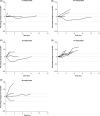Tolerability and efficacy of durvalumab in Japanese patients with advanced solid tumors
- PMID: 30891877
- PMCID: PMC6501043
- DOI: 10.1111/cas.14003
Tolerability and efficacy of durvalumab in Japanese patients with advanced solid tumors
Abstract
Blockade of programmed cell death ligand-1 with durvalumab has shown efficacy and safety in large, international studies of patients with advanced solid tumors. A phase 1, non-randomized, open-label multicenter study was initiated to evaluate durvalumab in a Japanese population. The first part of this study used a standard 3 + 3 dose-escalation design to determine the optimal dosing schedule of durvalumab. Primary objective was evaluation of safety and tolerability of durvalumab monotherapy. Secondary objectives were to evaluate maximum tolerated dose (MTD), immunogenicity, pharmacokinetics, and efficacy. Twenty-two patients (median age, 61.5 years; range, 41-76; 64% male) received durvalumab at doses of 1, 3, or 10 mg/kg every 2 weeks (q2w), 15 mg/kg q3w, or 20 mg/kg q4w. Twenty patients discontinued before completing 12 months of treatment as a result of progressive disease and two due to adverse events (AE). The most common treatment-related AE (trAE) were rash (18%) and pruritus (14%); two patients had grade ≥3 trAE including one patient each with hyponatremia and hypothyroidism. No patient experienced a dose-limiting toxicity (DLT) during the DLT evaluation period and the MTD was not identified. There were no AE leading to a fatal outcome during study treatment. Durvalumab showed dose-proportional pharmacokinetics across the 1-20 mg/kg dose range; incidence of positive titers for antidrug antibodies was 9%. One patient with lung cancer had a partial response and disease control rate at 12 weeks was 36%. In conclusion, durvalumab at the doses and regimens evaluated was safe and well tolerated in Japanese patients with advanced solid tumors.
Keywords: PD-L1; advanced solid tumor; dose escalation; durvalumab; immune checkpoint blockade.
© 2019 The Authors. Cancer Science published by John Wiley & Sons Australia, Ltd on behalf of Japanese Cancer Association.
Conflict of interest statement
Yutaka Fujiwara from AbbVie, AstraZeneca, Bristol‐Myers Squibb, Chugai Pharma, Daiichi Sankyo, Eisai, Incyte, Lilly, Merck Serono, MSD, Novartis (research funding), AstraZeneca, Bristol‐Myers Squibb, MSD, Ono Pharmaceutical (honoraria). Haruo Iguchi from AstraZeneca (research funding), Lilly, Nihon Medi‐Physics, Taiho Pharmaceutical, Yakult (honoraria). Noboru Yamamoto from AstraZeneca (research funding). Manabu Hayama, Shinya Ueda, Masahiro Nii, Keiko Komuro, Mariko Sugimoto and Gordana Vlahovic from AstraZeneca (employees). Gordana Vlahovic from Genentech/Roche, Pfizer (honoraria), Bristol‐Myers Squibb, Genentech/Roche, Pfizer (Consulting or Advisory Role), Genentech/Roche Pfizer, (Speakers' Bureau), Bristol‐Myers Squibb (Research Funding), Bristol‐Myers Squibb, Genentech/Roche, Pfizer (travel, accommodations, expenses). Toshiyuki Kozuki from AstraZeneca, Chugai Pharma, Kyowa Hakko Kirin, Lilly, Roche Pharma AG, Taiho Pharmaceutical (honoraria), AstraZeneca (research funding).
Figures
Similar articles
-
Phase I study of a recombinant attenuated oncolytic virus, MEDI5395 (NDV-GM-CSF), administered systemically in combination with durvalumab in patients with advanced solid tumors.J Immunother Cancer. 2024 Nov 17;12(11):e009336. doi: 10.1136/jitc-2024-009336. J Immunother Cancer. 2024. PMID: 39551600 Free PMC article. Clinical Trial.
-
Safety and antitumour activity of durvalumab plus tremelimumab in non-small cell lung cancer: a multicentre, phase 1b study.Lancet Oncol. 2016 Mar;17(3):299-308. doi: 10.1016/S1470-2045(15)00544-6. Epub 2016 Feb 6. Lancet Oncol. 2016. PMID: 26858122 Free PMC article. Clinical Trial.
-
A Canadian cancer trials group phase IB study of durvalumab (anti-PD-L1) plus tremelimumab (anti-CTLA-4) given concurrently or sequentially in patients with advanced, incurable solid malignancies.Invest New Drugs. 2020 Oct;38(5):1442-1447. doi: 10.1007/s10637-020-00904-7. Epub 2020 Feb 4. Invest New Drugs. 2020. PMID: 32020438 Clinical Trial.
-
Durvalumab for the treatment of non-small cell lung cancer.Expert Rev Anticancer Ther. 2019 Dec;19(12):1009-1016. doi: 10.1080/14737140.2019.1699407. Epub 2019 Dec 3. Expert Rev Anticancer Ther. 2019. PMID: 31782989 Review.
-
Durvalumab: an investigational anti-PD-L1 antibody for the treatment of biliary tract cancer.Expert Opin Investig Drugs. 2021 Apr;30(4):343-350. doi: 10.1080/13543784.2021.1897102. Epub 2021 Mar 9. Expert Opin Investig Drugs. 2021. PMID: 33645367 Review.
Cited by
-
Treatment-Related Serious Adverse Events of Immune Checkpoint Inhibitors in Clinical Trials: A Systematic Review.Front Oncol. 2021 May 11;11:621639. doi: 10.3389/fonc.2021.621639. eCollection 2021. Front Oncol. 2021. PMID: 34046338 Free PMC article.
-
Current Progress and Future Perspectives of Immune Checkpoint Inhibitors in Biliary Tract Cancer.Onco Targets Ther. 2021 Mar 12;14:1873-1882. doi: 10.2147/OTT.S269671. eCollection 2021. Onco Targets Ther. 2021. PMID: 33737812 Free PMC article. Review.
-
Immunotherapy resistance in esophageal cancer: Possible mechanisms and clinical implications.Front Immunol. 2022 Sep 2;13:975986. doi: 10.3389/fimmu.2022.975986. eCollection 2022. Front Immunol. 2022. PMID: 36119033 Free PMC article. Review.
-
First-line durvalumab plus platinum-etoposide in extensive-stage small-cell lung cancer: CASPIAN Japan subgroup analysis.Int J Clin Oncol. 2021 Jun;26(6):1073-1082. doi: 10.1007/s10147-021-01899-8. Epub 2021 Apr 7. Int J Clin Oncol. 2021. PMID: 33826027 Free PMC article.
-
Efficacy and safety of immune checkpoint inhibitors versus chemotherapy in the second-line treatment of advanced esophageal squamous cell carcinoma: a meta-analysis and systematic review.J Thorac Dis. 2023 Mar 31;15(3):1186-1195. doi: 10.21037/jtd-22-1169. Epub 2023 Mar 15. J Thorac Dis. 2023. PMID: 37065572 Free PMC article.
References
-
- Frydenlund N, Mahalingam M. PD‐L1 and immune escape: insights from melanoma and other lineage‐unrelated malignancies. Hum Pathol. 2017;66:13‐33. - PubMed
Publication types
MeSH terms
Substances
Grants and funding
LinkOut - more resources
Full Text Sources
Other Literature Sources
Research Materials


